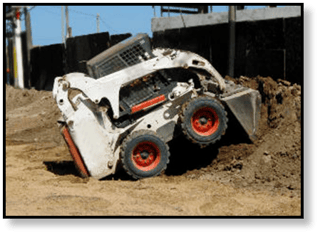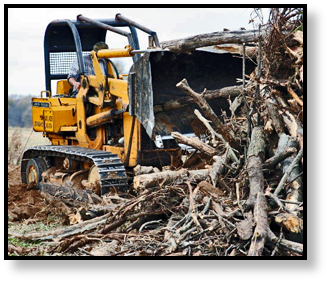
Besides equipment failure, there is one other occurrence that can stop a construction project in its tracks: heavy equipment theft. In average, experts estimate that equipment theft results in $400 million of equipment alone, not including down time, project delays, rental costs, etc. In this blog post, we are going to review what you need to know about equipment theft in the US.
Here are some other Shop Talk blog posts you might find interesting:
- 18 Tips to Help Minimize Operating Costs for Skid Steers
- Heavy Equipment, Telematics, and the Internet of Things
- The Very Real Dangers of Reactive Maintenance of Final Drives
The most recent information from the National Insurance Crime Bureau (NICB) and National Equipment Register (NER) have estimated that heavy construction equipment thefts range from $300 million to $1 billion per year – and in 2014, only 23% of stolen equipment was recovered. This is a serious problem for both small contractors and those responsible for large fleets.
Types of Equipment at Highest Risk
In 2014, the NICB reported that the three most popular pieces of equipment to be stolen were mowers, loaders, and tractors. Brands, in order of popularity, were John Deere, Kubota, Bobcat, Caterpillar, and Toro. In their 2014 report on heavy equipment theft, the NER noted that loader thefts included primarily skid steers, followed by backhoes and wheel loaders.
 It seems that the heavy equipment most likely to be the target of thieves must meet two requirements: mobility (e.g., can it be moved on a small trailer) and value (there is a market for it and it is expensive).
It seems that the heavy equipment most likely to be the target of thieves must meet two requirements: mobility (e.g., can it be moved on a small trailer) and value (there is a market for it and it is expensive).
When several machines meeting these requirements are available to choose from, you can already guess the result: the newer machine will be the stolen.
The NER also pointed out that while a large excavator may be much more valuable than a small skid steer, it is going to be much more difficult to steal because it is hard to move -- making it less of a target for theft. That means mobility trumps value.
Areas with the Highest Risk
 In the same NER report, the authors observed that theft levels seem to be related to how much construction equipment is present in a particular area. Organized theft rings seem to develop in regions where there is a combination potential buyers and a large amount of equipment available.
In the same NER report, the authors observed that theft levels seem to be related to how much construction equipment is present in a particular area. Organized theft rings seem to develop in regions where there is a combination potential buyers and a large amount of equipment available.
As far as those with insured equipment, most thefts did not occur on the owner's premises but rather at job sites, per the same NER report. This is due in part, no doubt, to the reduced level of security at remote job site as compared to the owner’s premises.
Another interesting fact noted by the NER report is that more thefts occur per person in areas with lower populations. This implies that thefts are more likely to occur in rural areas than in metropolitan areas.
Tips and Guidelines for Preventing Theft
Here is what the NICB recommends for discouraging theft:
- Maintain a thorough database of all equipment, recording the make, model, PIN, serial number, production date, and purchase date and including photos of each piece of equipment
- Post signs on site informing potential thieves of the fact that you have a record of each piece of equipment on site -- they know this can make it more challenging for them to sell it
- Engrave or stamp equipment with a company logo, identifying marks, or identification numbers
- When equipment is going to be unattended, remove circuit breakers and fuses
- After hours or on weekends, make it challenging to move the equipment by using the old-fashioned “wagon circle” method, surrounding more easily transported items by large pieces of equipment
- Use sleeve locks to fix backhoe pads in an extended position to keep the wheels off the ground
- Make use of hydro locks to fix articulated equipment so that it cannot travel in a straight line
- Install hidden fuel shut-off systems

Here are some additional tips for preventing the theft of your heavy equipment:
- Duplicate key serial numbers on our equipment using a punch or an engraver
- Use fences where feasible, and where fences don’t work then setup barriers, such as ditches or posts, to make it difficult to remove the equipment from the worksite
- Keep the perimeter of the job site well-lit at night
- Make it easy to spot missing equipment – for example, at the end of the day line the equipment up in straight row, with the more valuable pieces toward the center where they can quickly be spotted OR in a circle as described earlier
- Don’t leave your equipment unattended on a trailer
- Randomly check the site on weekends and off hours
Other options include, but certainly are not limited to, registering your equipment on a national database, installing GPS trackers on your equipment, and investing in cameras and security devices. Depending on how much you have invested in your equipment, you might also want to consider hiring security for the job site if you are in a high-risk area.
Conclusion
Equipment theft is a serious problem that is not likely to go away, but being aware of the risks and taking some steps toward securing equipment on the job site can help keep you from becoming one of the statistics.
Get your free ebook on "How to Ship a Final Drive Motor?" This handy resource guide created by Texas Final Drive provides you with simple methods to ship your final drive motor that could save you money!

